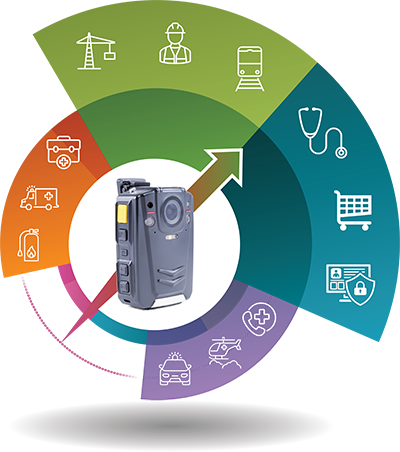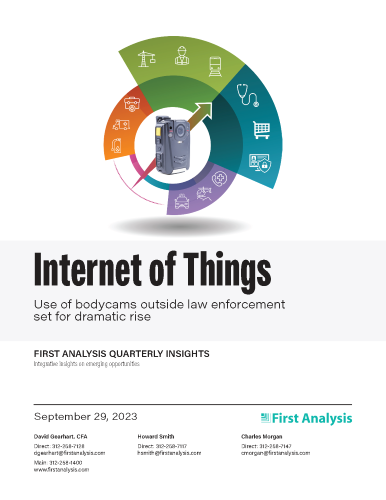Quarterly insights: Internet of Things
Use of bodycams outside law enforcement set for dramatic rise

Law enforcement has been the most aggressive adopter of body-worn cameras. Over 70% of agencies across the United States have implemented a bodycam solution, realizing compelling benefits including increased safety for officers and the public they serve and increased transparency in policing.
However, there are many sectors outside first responders that would benefit from deploying bodycams, and interest in deploying bodycams in such sectors has been building over the last few years. We believe this opportunity is at least 13 times the size of the first-responder market: There are more than 22.5 million potential bodycam users in other sectors.
We detail the factors we believe are fostering growing demand for bodycam solutions in both first-responder and private-sector markets, including perceived and real increases in danger for employees, the need to improve consumer satisfaction and employee productivity, and increased societal acceptance of omnipresent video surveillance in public and commercial settings.
We identify strategies and capabilities that are likely to characterize the most successful companies addressing the growing opportunity to provide bodycam solutions outside traditional law-enforcement markets, and we profile several innovative providers.
TABLE OF CONTENTS
- Traditional first responder tool provides ground-level intelligence and context
- Anatomy of a solution
- Main adoption drivers in law enforcement
- Relevant beyond first responders
- Incremental adoption drivers in non-traditional markets
- Interest rising on changing perceptions of crime levels and law enforcement engagement
- Outside first responders, addressable market much larger
- Characteristics useful in predicting successful vendors
- Other thoughts
- Company profiles
- IoT index constituents mostly left out of market recovery
- IoT M&A: Notable transactions include CrowdAI and Twilio’s IoT business
- IoT private placements: Notable transactions include Platform Science and Nami
Traditional first responder tool provides ground-level intelligence and context
Bodycams, short for body-worn cameras, are a class of wearable video solutions for recording interactions with the public and collecting evidence. These cameras, which feature an outward-facing lens to capture the wearer’s perspective, are typically worn on the chest or shoulder but can be mounted elsewhere, such as on the head. They can record continuously or only segments of time when manually activated by wearers or when automatically triggered by nearby devices or software. This visual footage, along with accompanying audio tracks and other sensor data, is viewable through web-based applications on smartphones, tablets and desktop computers. While these solutions are applicable to many sectors, law enforcement personnel, including police, corrections officers, and government agency officers, as well as first responders such as fire, rescue and ambulance teams, have been the most visible users of bodycams. The cameras are used to mitigate risk and enhance compliance and for training and other support.
Anatomy of a solution
Bodycam solutions, which typically combine core camera hardware and accessories with software and platform tools and vary dramatically in terms of capabilities and sophistication, with offerings ranging from basic to highly advanced. Most bodycams feature a ruggedized enclosure, high-definition recording capabilities, internal memory, a manual activation button, mechanisms to indicate to the public that recording is in progress, and charging via a dock. They often vary in terms of wireless capabilities, with the most basic bodycams using tethering (wired connection) to offload video in contrast to more modern solutions that use Wi-Fi, cellular or both to upload footage as well as enable remote access (live-streaming) for partners. Other features characterizing stronger offerings include edge processing, pre-event video capture (using buffering), automatic recording triggered by nearby devices or computer vision and artificial intelligence, two-way voice communication, in-field annotation, and embedded sensors such as GPS for location and accelerometers for fall detection. On the software side, every application allows users to view, edit, categorize, search and share video in addition to providing basic functions around device and user management, auditing and reporting. More advanced software allows users to import and manage footage from third-party devices and software systems and features robust tools for editing footage, building cases and automating workflows. Ultimately, the solution adopted depends on how needs and budget stack up against depth of hardware and software capabilities.
Main adoption drivers in law enforcement
Law enforcement has been the most aggressive among first responders in adopting bodycams. Over 70% of agencies across the United States have implemented a bodycam solution. For many, bodycams have become a standard piece of equipment, with most officers in the field using them every shift. This high penetration rate is unsurprising, considering the first bodycams were designed for police and available only to law enforcement for many years afterward. But it is bodycams’ ability to unlock a handful of core benefits that has been responsible for driving their widespread adoption. These include:
Post-incident forensics and legal support. Video footage and associated audio files provide unique visibility into situations and events, enabling later reviewers to better understand the contexts in which they occurred. This deep level of insight helps organizations more quickly assign fault to individuals or, alternatively, exonerate others, and the footage can be used to either increase the probability of a successful prosecution or defend against false allegations and meritless lawsuits.
Behavior modification and deterrence. People tend to respond differently when a camera is present given the potential to be recorded and for any negative footage to be used against them. In general, people acting inappropriately, such as being physically violent, threatening, or verbally abusive, modify their behavior when officers wearing cameras arrive, often by de-escalating and switching from an aggressive posture to a more passive posture. Cameras also keep individuals relatively civil, deterring them from escalating to an aggressive state. Cameras affect behavior of their wearers similarly, and officers are more likely to act with greater professionalism and comply with process and procedures guidelines. The result is situations often conclude without violence. Use-of-force incidents are lower and fewer individuals, including officers, are harmed overall. One vendor found that bodycams stimulate good behavior, reducing violent incidents by up to 80%. In addition, individuals are less likely to file complaints, make false accusations or pursue meritless lawsuits if a bodycam was present and footage may exist contradicting their position.
Training and process changes. Bodycam footage of real-world situations is valuable as it can be used in training programs to educate new staff on what to do and not do in certain scenarios. Viewers can compare different approaches and the resulting outcomes. Bodycam footage can also be used to highlight to bodycam wearers what they did incorrectly in handling a situation and how retraining can help achieve better outcomes. Alternatively, footage can highlight exceptional performance warranting personal recognition or incentive-based compensation. Footage can also reveal process or other deficiencies and provide insights that can be used to improve procedures.
Transparency, accountability and trust. There is a lingering perception that police officers are untrustworthy and that they are inclined to abuse their sanctioned authority by selectively and even aggressively enforcing the law. This likely stems from highly publicized incidents that make it appear such events are more frequent than they really are. Bodycams, which provide impartial visibility into actual situations and police responses, are a means to combat this negative perception. By deploying bodycams, law enforcement agencies establish more open relationships with the public and demonstrate high transparency. In addition and by extension, these agencies are effectively making a statement that officers who act inconsistently with their training and the law will be held accountable based on these recordings. This willingness to be open and honest with the public and to hold individuals accountable is what ultimately rebuilds trust and improves perception.

Request full report
To access the full report, please provide your contact information in the form below. Thank you for your interest in First Analysis research.
